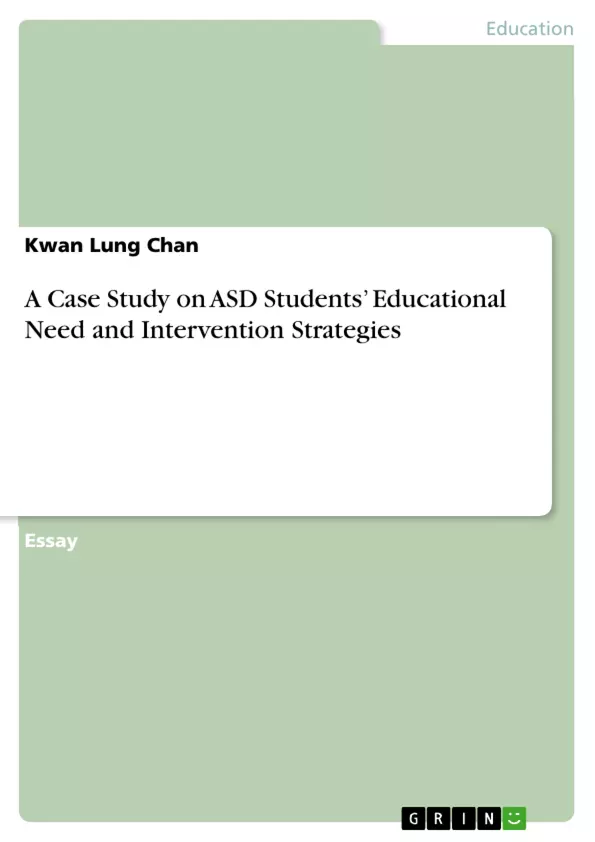Mitch is a primary one student who demonstrates a set of unusual behavior. He has special educational needs and needs to see a speech therapist (Weybright, 2016). This essay will first analysis what special educational need he has, then find out the causes of his special educational need, and finally propose possible intervention strategies that can help Mitch in relieving the problem, with clear suggestions on what parties should what in the whole-school-approach implementation of the strategies.
Inhaltsverzeichnis (Table of Contents)
- Introduction
- Analysis on Mitch's Educational Need
- Cause of Mitch's Conversation Monopoly: Theory of Mind Deficits
- Cause of Mitch's Conversation Monopoly and Attention Problem: Executive Functioning Deficits
- Cause of Mitch's Speech Impairment: Information Processing Deficits
- Intervention Strategies: Social Stories
- Intervention Strategies: Vocabulary Labels
- Intervention Strategies: Travel Cards
- Intervention Strategies: Rational Emotive Behavioral Therapy
- Intervention Strategies: Sibling Responsibility in Care-taking
- Government Monetary Support for Intervention Strategies
Zielsetzung und Themenschwerpunkte (Objectives and Key Themes)
This essay aims to analyze the special educational needs of a primary one student named Mitch, who exhibits autistic characteristics. The essay seeks to identify the causes of his special needs and propose intervention strategies that can effectively address his challenges, focusing on a whole-school approach implementation.
- Autistic Spectrum Disorder (ASD) characteristics and their manifestation in Mitch's case
- Theoretical explanations for Mitch's specific difficulties: Theory of Mind, Executive Functioning, and Information Processing
- Practical intervention strategies for addressing social, cognitive, and communication challenges
- The role of a whole-school approach in the implementation of intervention strategies
- Government funding and support for special educational needs (SEN) students in Hong Kong
Zusammenfassung der Kapitel (Chapter Summaries)
- Introduction: Introduces Mitch, a primary one student with special educational needs, and outlines the essay's objectives. The essay will analyze his special needs, explore the causes, and propose intervention strategies.
- Analysis on Mitch's Educational Need: Describes Mitch's autistic characteristics based on Tsang & Bong's (2016) categorization of ASD traits, including difficulties in social interaction and communication, social cognition deficits, repetitive patterns of behavior, and sensory sensitivities.
- Cause of Mitch's Conversation Monopoly: Theory of Mind Deficits: Explains Mitch's conversation monopoly and difficulty with social interaction through the lens of Theory of Mind deficits. It discusses the challenges faced by ASD children in understanding others' mental states, particularly in reading facial expressions and interpreting non-verbal cues.
- Cause of Mitch's Conversation Monopoly and Attention Problem: Executive Functioning Deficits: Attribues Mitch's conversational monopoly and attention problems to deficits in executive functioning skills. It explores how ASD individuals struggle with inhibiting responses, planning actions, and maintaining attention due to limitations in working memory.
- Cause of Mitch's Speech Impairment: Information Processing Deficits: Explains Mitch's speech impairment through the framework of information processing deficits. It examines the challenges ASD children face in acquiring declarative knowledge (knowing that something is the case), which often requires abstract thinking skills.
- Intervention Strategies: Social Stories: Proposes social story interventions to help Mitch learn social skills like listening, eye contact, and attention. These stories should be tailored to Mitch's perspective and include visual cues to enhance understanding.
- Intervention Strategies: Vocabulary Labels: Suggests the use of vocabulary labels around the school campus to support Mitch's vocabulary development. Teaching assistants and peers can help him identify the correct word when he makes errors.
- Intervention Strategies: Travel Cards: Describes the travel cards strategy as a method for encouraging desirable behaviors in Mitch, such as listening, eye contact, and attentiveness. This involves a system of rewards based on achieving desired behaviors during lessons.
- Intervention Strategies: Rational Emotive Behavioral Therapy: Presents rational emotive behavioral therapy (REBT) as an approach to address Mitch's anxiety. Teachers, peers, and parents can identify triggers for his anxiety, and counsellors can help him challenge irrational beliefs contributing to his emotional distress.
- Intervention Strategies: Sibling Responsibility in Care-taking: Emphasizes the importance of involving siblings in caring for Mitch. Siblings can play a role in supporting his learning and development by reading social stories, placing vocabulary labels, and providing other forms of assistance.
- Government Monetary Support for Intervention Strategies: Explains the availability of government funding in Hong Kong for supporting SEN students. Mitch's school can access resources for intensive remedial teaching, learning support, and enhanced speech therapy to aid in implementing intervention strategies.
Schlüsselwörter (Keywords)
This preview focuses on ASD, special educational needs, intervention strategies, Theory of Mind, Executive Functioning, Information Processing, whole-school approach, government funding, and home-school collaboration. The text explores the specific case of Mitch, a primary one student with ASD, highlighting the importance of tailoring educational interventions to individual needs and advocating for collaborative approaches involving teachers, parents, and siblings.
- Citation du texte
- Bachelor of Education (Music) Kwan Lung Chan (Auteur), 2016, A Case Study on ASD Students’ Educational Need and Intervention Strategies, Munich, GRIN Verlag, https://www.grin.com/document/448150



